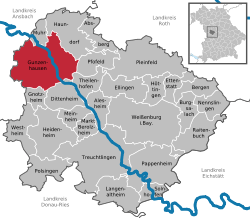Gunzenhausen
| Gunzenhausen | ||
|---|---|---|
 | ||
| ||
 Gunzenhausen | ||
Location of Gunzenhausen within Weißenburg-Gunzenhausen district  | ||
| Coordinates: 49°06′53″N 10°45′15″E / 49.11472°N 10.75417°ECoordinates: 49°06′53″N 10°45′15″E / 49.11472°N 10.75417°E | ||
| Country | Germany | |
| State | Bavaria | |
| Admin. region | Mittelfranken | |
| District | Weißenburg-Gunzenhausen | |
| Subdivisions | 14 Stadtteile | |
| Government | ||
| • Mayor | Joachim Federschmidt (SPD) | |
| Area | ||
| • Total | 82.73 km2 (31.94 sq mi) | |
| Elevation | 416 m (1,365 ft) | |
| Population (2012-12-31)[1] | ||
| • Total | 16,171 | |
| • Density | 200/km2 (510/sq mi) | |
| Time zone | CET/CEST (UTC+1/+2) | |
| Postal codes | 91710 | |
| Dialling codes | 09831 | |
| Vehicle registration | WUG | |
| Website | www.gunzenhausen.de | |
Gunzenhausen is a town in the Weißenburg-Gunzenhausen district, in Bavaria, Germany. It is situated on the river Altmühl, 19 kilometres (12 mi) northwest of Weißenburg in Bayern, and 45 kilometres (28 mi) southwest of Nuremberg. Gunzenhausen is a nationally recognized recreation area.
History
Numerous excavations within the city of Gunzenhausen document that the area was occupied and there was a settlement in pre-historic time. In the year 90 the Romans expelled the Celts, occupied the inhabited areas north of the Donau River and expanded into the Gunzenhausen area. In the year 241 the Alemanni invaded the area and destroyed the fortress. A document from the year 823 supplies the first reliable written reference to Gunzenhausen.
Emperor Ludwig der Fromme conveyed the monastery "Gunzinhusir" to the High-monastery of Ellwangen. Later the "Truhendinger" and the "Oettinger" families became Lords of Gunzenhausen, and in 1368 Gunzenhausen came to the House of Hohenzollern. So the city received the right of holding fairs and was allowed to build city walls, towers and moat, as well as a large church. Gunzenhausen had a big Jewish community and a wonderful mauric synagogue.
In the 1970s eighteen municipalities were combined resulting in the city growing to about 17,000 inhabitants.
International relations
Gunzenhausen is twinned with:
References
- ↑ "Fortschreibung des Bevölkerungsstandes". Bayerisches Landesamt für Statistik und Datenverarbeitung (in German). 31 December 2012.
| Wikimedia Commons has media related to Gunzenhausen. |
| |||||||
